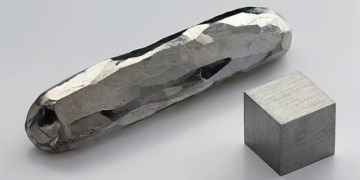Daruma Dolls: A Cultural and Historical Symbol for the Japanese.
Daruma is a traditional Japanese doll that has become a symbol of perseverance and good luck in Japan. However, outside of Japan, not many people are aware of the history behind this whimsical-looking doll.
Imagine you are visiting Japan. You have just a few days left before returning home and need to choose a souvenir. It should be unique, avoiding typical keychains featuring famous landmarks or even the occasional KitKat (a “specialty” of Japan). In that case, few items are as rich in identity and unexpected as a Daruma doll.
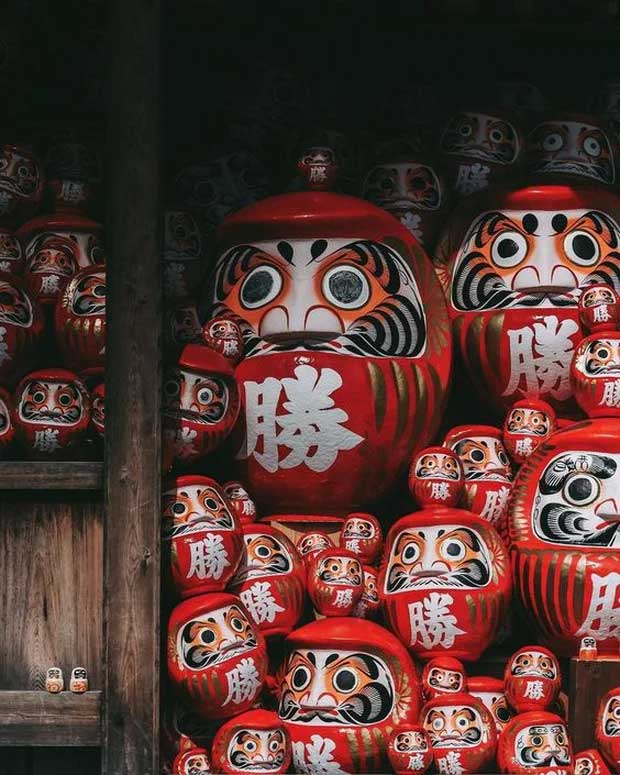
Daruma is a traditional Japanese doll.
Daruma is truly one of Japan’s symbols. But beyond being cute and distinctive, this doll also represents a legendary figure, has a long history, a rich heritage, and a special origin.
The Legend Behind the Daruma Doll
Daruma is modeled after the shape of Bodhidharma, who is believed to be the founder of Zen Buddhism and lived around the 5th to 6th century. His origins remain shrouded in mystery, and most of the records about his life are based on folklore.
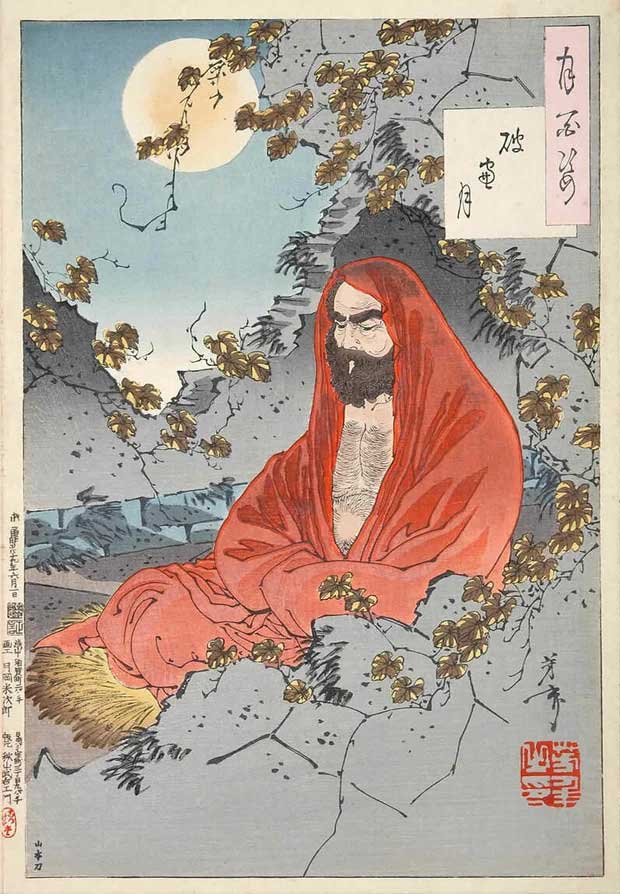
Ukiyo-e woodblock print of Bodhidharma.
Legends suggest various hypotheses about Bodhidharma, such as his origins from India or Persia. According to tales, he traveled eastward and stopped at Shaolin to teach martial arts before continuing his journey and settling in a cave for meditation. This is also when the legend of Daruma (the Japanese pronunciation of Bodhidharma) began.
According to legend, he meditated in silence for nine years, only closing his eyes once after seven years. Frustrated with what he perceived as a lack of self-discipline, the monk cut off his eyelids so he would never sleep again. When his eyelids fell to the ground, they sprouted into a tea plant. From this legend, Japanese monks often drink tea to stay alert.
Moreover, the legend states that due to his immobility for nine years, his limbs fell off. This is why the Daruma doll distinctly lacks arms and legs and possesses wide-open eyes.
Deep Symbolism of Daruma
Every aspect of Daruma’s appearance carries specific symbolism.
One of the most notable features of Daruma is its empty eyes. These dolls do not have pupils; instead, they feature large circles for eyes. One theory behind this design choice relates to the legend of Bodhidharma cutting off his own eyelids.
A more common perspective suggests that it stems from the fact that in the past, those who wished for a deity to reside in the doll to help them achieve their goals would vow to grant Daruma sight if the deity helped them succeed. To symbolize this, they would draw eyes on Daruma once their wish was fulfilled.

Eyebrows shaped like a crane and a beard resembling a turtle.
The beard and eyebrows painted on the doll are meant to replicate Bodhidharma’s facial features, but they serve more than just an aesthetic purpose. In fact, the eyebrows are shaped like a crane, and the beard resembles a turtle.
These two animals often symbolize longevity in Japanese culture as well as in many East Asian countries. Craftsmen began incorporating these shapes into Daruma to align with the Japanese proverb meaning “Cranes live a thousand years, turtles live ten thousand years.”
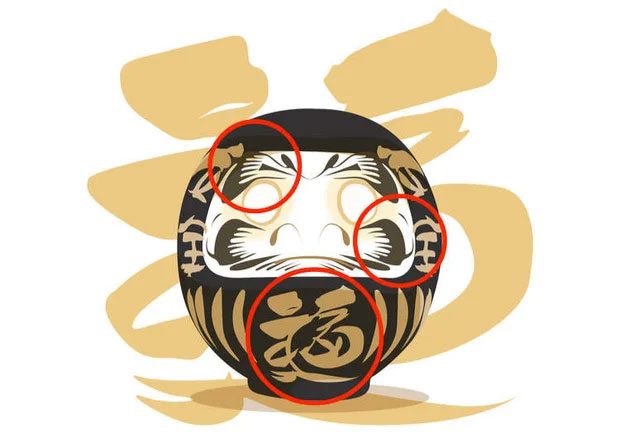
The doll is designed like a roly-poly toy and cannot fall over.
Regarding its body, the fact that Daruma lacks limbs symbolizes the sacrifices made to achieve enlightenment by Bodhidharma. However, this characteristic also gives the doll a roly-poly design, making it unable to fall over—symbolizing resilience.
This serves as a reminder encapsulated in the Japanese proverb nanakorobi yaoki (fall seven times, stand up eight), a reminder that even if knocked down, one must continue to rise.
Additionally, the body of Daruma often features kanji characters that symbolize good fortune or express the owner’s wishes.
Finally, although red is the most famous color, Daruma can come in various colors depending on the wish. For instance, yellow represents wealth, black is for warding off bad luck, and green signifies health.
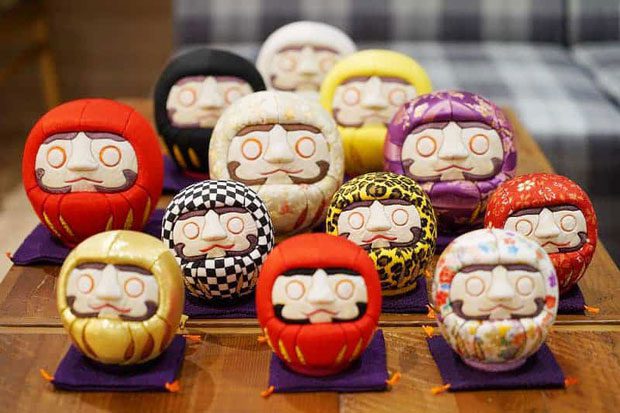
Although red is the most famous color, Daruma can come in various colors depending on wishes.
However, according to legend, red is the original color. The Japanese believe it is the color of Bodhidharma’s robe; moreover, red symbolizes good luck in East Asian culture.
Daruma in Modern Japanese Culture
Historically, the first Daruma doll was created in the 17th century in Takasaki, Gunma Prefecture, by a farmer as a talisman blessed by monks.
As the farmer’s livelihood heavily depended on the luck of the harvest, this meaning gradually became associated with Daruma, turning it into a good luck charm for its users.
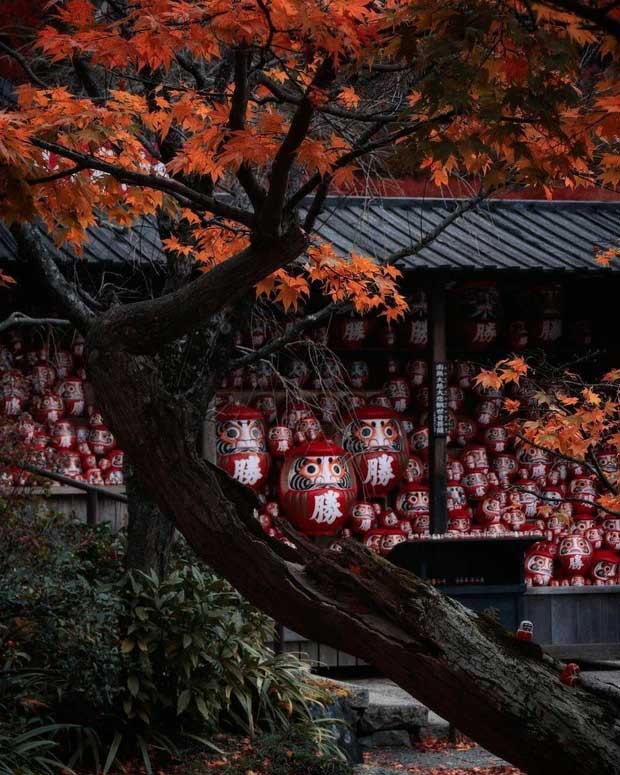
Daruma is often purchased to help bring good luck for success.
In modern times, Daruma has become a souvenir, a display item, and a cute gift. However, it has not entirely lost its original power in the collective imagination. While it may not be common to find people who know the full history behind this good luck charm, Daruma is still often purchased to help bring good luck for success.
After buying a Daruma, people will color in one eye while striving to fulfill their wishes and sincerely praying. Once they achieve their goal, the second eye will be colored in to express gratitude and restore full sight to Daruma.
One year after purchasing Daruma, individuals may bring it back to the temple where they bought the doll to burn it, regardless of whether their wish was fulfilled. There is even a festival called daruma kuyo or dondoyaki held at many temples in Japan to collectively burn Daruma.

The use of Daruma is not limited to businesses or certain private households.
Today, Daruma dolls are still used to decorate restaurants, shops, or homes to bring good luck. Its size also reflects the level of a person’s wishes, as it is believed that the larger the doll, the greater the aspirations of its owner.
However, the use of Daruma is not limited to businesses or certain private households. Over the centuries, this doll has achieved a privileged position in Japanese culture, to the extent that it tends to appear in various situations and locations.
For example, politicians often bring their dolls to interviews, speeches, especially during election times. Like others who own Daruma, they have a wish and commit to returning the favor to the deity by restoring sight if granted.
It can be argued that this also delves into a cultural belief in Japan, where a politician can express their determination and commitment to the country and its people through the symbol associated with Daruma.
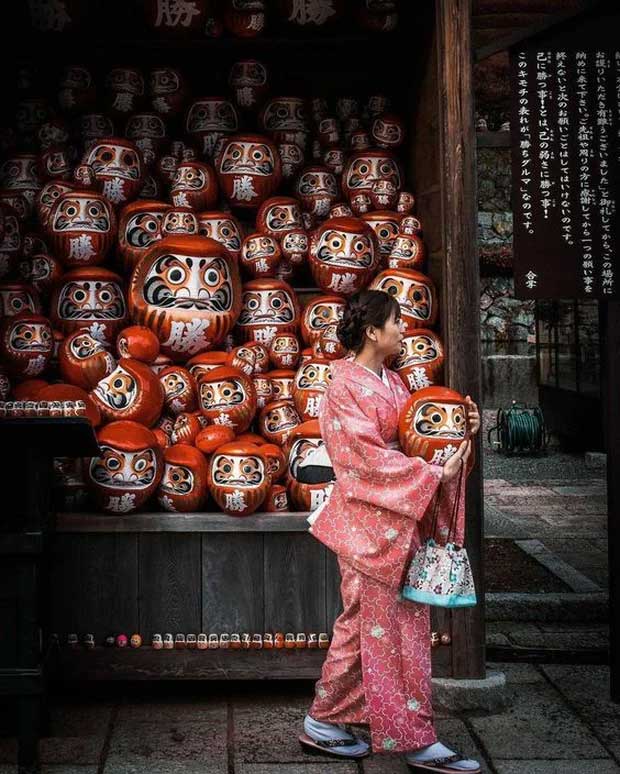
This doll has achieved a privileged position in Japanese culture over the centuries.
This familiar Japanese souvenir has certainly undergone many changes and interpretations throughout history. It is regarded as a deity that can help achieve success. It represents one of the most important aspects of Zen Buddhism related to patience, perseverance, and sacrifice.
While Japan boasts a fascinating culture rich in symbols and traditions, few other images from this country can match the origins and diverse meanings that deeply resonate within society like Daruma.




















































